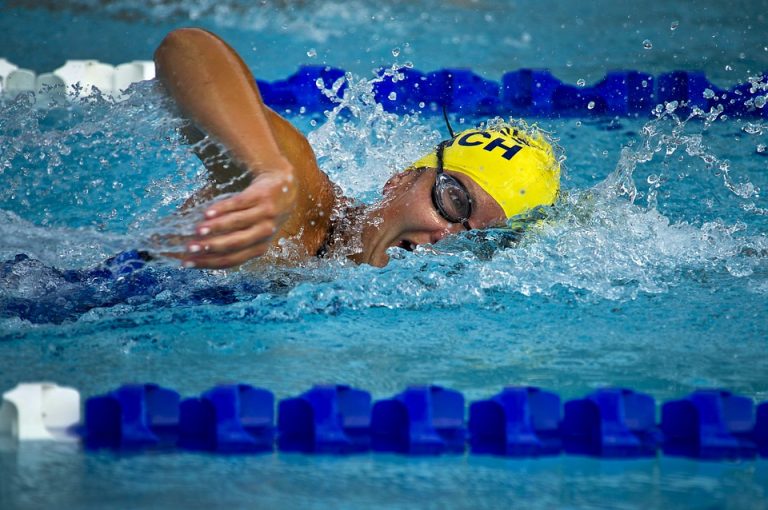Do you spend the summer with the feeling that something is missing? Do you wish you could get in the water and fully enjoy yourself? Swimming is an important skill to move in water, both in the sea and in swimming pools. In addition, this exercise brings lightness and relaxation.
On the other hand, many people defend themselves and swim in a certain way, but do they do it correctly? Do they swim in the best possible way? Do they handle different styles?
Swimming is one of the best aerobic sports that exist, since with it you work almost all the muscles of the body. It is also considered a low impact sport. This means that the body hardly suffers while you are practicing this exercise.
 Would you like to go into the sea or the pool without worries, simply enjoying a moment of relaxation or exercise? Do you want to learn how to swim? Do you want to learn different swimming styles? Then this article is for you. Read on to find out how to swim.
Would you like to go into the sea or the pool without worries, simply enjoying a moment of relaxation or exercise? Do you want to learn how to swim? Do you want to learn different swimming styles? Then this article is for you. Read on to find out how to swim.
If you want to learn to swim for the first time, don’t worry, almost everyone can do it, some more quickly than others, but with these steps that we are going to give you below, you will achieve it.
Lose the fear
Before starting with the technical steps you must lose your fear and feel calm in the water. Fear is the first reason why many people do not enjoy the water and also have not learned to swim well.
That you stop fearing that you could drown does not mean that you take everything as a game and lightly, because it is true that risks exist and that accidents do happen, even for expert or professional swimmers, complete safety is not a guarantee.
Security advice
However, as long as you are careful and comply with these safety tips, you can swim with complete peace of mind and minimize risks.
Always swim with people nearby. Try to go swimming with a person who has this ability much more developed than you, and if not at least there are more people near you. Never go swimming alone.
Watch the depth. While you are learning to swim, always stay in areas where you can perfectly stand up without the water going past your neck. This way you can always get up and be safe if something happens or if you get nervous. Weather
_. If you are going to swim at the beach you should always check the weather beforehand. You should never go swimming in bad weather such as rain, strong winds or storms. Also, if you are in the water and notice a sudden change in the weather, the best thing you can do is get out of the water and take cover.
The currents. Some sea currents can be treacherous, so while you are starting at least tries to swim in pools or sea waters without currents. If later you want to try swimming with currents you should always observe and find out how the current works, for example if it attracts the open sea or if it pushes towards the coast.
The temperature. The temperature of the water in which you are going to swim is also important since very cold water can numb your extremities, preventing you from moving them as you should.
Learn-to-float
Learning to float will be the first thing we must learn before starting to swim. The feeling of relaxation and freedom that is experienced floating is wonderful, it will also be very useful for us at times when we need to rest while swimming in deep water.
To begin with, you can grab onto the edge of the pool or a companion in the sea. While you are holding on with your hands let your legs float. Don’t control them, just set them free. You can then hold on with one hand and lie down to start floating with your whole body. You can float on your back, which is usually much easier, but with your face in the water you cannot breathe and recover, so it is best to learn to float on your back. It is important that you feel comfortable and relaxed while you do it, although at first it can be a bit of a rush and you may even feel uncomfortable when you feel the water close to your ears.
To float on your back stretch your body completely. Stretching the legs and arms forming a cross usually helps to give greater stability. Your nose and mouth will be above the water, but your ears will not. When floating, think that half of your body will be under water and the other half will be outside. To start and get the posture you will maintain the balance with your stomach and your back. If you do a little force to get belly, you will be able to float. As soon as you get used to this sensation and these positions, floating will be very easy and rewarding.
Learning to move in the water
The first movements that we will learn to swim will be kicking. These are the movements that we will make with our legs and that will allow us to gain momentum, move forward or float. To do this, start by moving your legs while you are floating, this allows you to see how your body moves according to what movements. We can also use a float, both to turn face down and face up while kicking. Thanks to these exercises we will see how far you can go with a kick. Using floats at the beginning is a great advantage, as you will be focusing solely on the technique of kicking and will free your mind from being attentive to staying afloat and with your head above the water. There are different kicking techniques that can help you swim and move.
Kicking ballerina. With this technique we will move the legs one at a time giving small kicks, while stretching the tips of the feet (as dancers do), in this way you will feel greater flexibility in the ankle area.
Spinning kick, water polo kick or eggbeater kick. This technique is the most used when you want to rest and keep the upper part of the body (head and shoulders) out of the water. It allows you to recover and stay afloat when you’re not on your feet. It is also widely used in water sports, such as water polo. To do the movements correctly, stand upright, bend your legs, bending your knees and separate your legs, they should be a little more open than the width of your hips. Now let’s do the moves. You must move your legs as if you were riding a bicycle, tracing circles, but keep in mind that one leg must go forward at the same time as the other goes back. This can be confusing at first, but don’t get overwhelmed, because with a little practice you will be able to do it easily.
The breaststroke kicks. The breaststroke kick is useful for moving forward and gaining momentum while swimming. To do it we will completely join the legs, from the thigh to the ankles. Then bend your knees forward at a 90 degree angle. Then separate the shin area by bringing each foot to its corresponding side in circles. The thighs should stay together the entire time as we make the circular movements.(Open each leg in a half circle, right leg to the right and left to the left, and at the end of the path the ankles must be brought back together before the movement is repeated).
Swimming techniques
There are different styles of swimming, let’s see some:
Front crawl swimming. Although it may seem like a professional style, it is really simple and the one that best allows you to move and advance in the water, so learning this style is highly recommended for beginners.
– Back crawl. To swim backwards you must lie on your back, stay afloat and move your legs kicking while making circular movements with your arms. The correct movement is raising the arm straight out of the water, bringing it back close to your head and when we reach the back completely, already in the water bend the arm a little so that it returns to the initial position close to your body. Perform this move by alternating arms. Also remember that the fingers of the hands should be as close together as possible and the hands should be very straight.
– Front crawl or freestyle. In this case we will lie down with the body face down keeping ourselves afloat. Kicking will propel you forward while helping you stay afloat. At the same time you must move your arms with the crawl movement. (Lift your arm out of the water, bring it forward, and lower it into the water. Scooping your hand will help you push the water back and then start again.) You should repeat the movement alternating each arm. The head will be mainly under water, so to breathe you must turn your head to the side, so that you can get enough air under the arm that you are raising at the time. Ideally, you should always breathe under the same arm, so be prepared to hold as long as you can and breathe every two strokes,
swimming doggie style. More than swimming, this style allows you to stay afloat and move slightly. In this case, move your legs with the water polo movement that we saw before and while you separate your arms, bending them slightly in front of your body and make circular movements with the middle of your arm (from the hands to the elbows).
Another style that can be of great use to you is learning to surface from the bottom. To do this you must put your hands vertically above your head straight, and then you will lower them quickly while kicking, in this way you will ascend with greater speed. Repeat the movements as many times as necessary until you get to the surface.
Advanced techniques and styles
After practicing the basic styles, and that you move and perform them with ease, you could decide to try other styles that are a little more advanced. These styles will give you faster movements while spending less energy doing them. Some of these techniques are the side stroke, breaststroke, butterfly stroke or the butterfly stroke.
Nailed
Once you feel comfortable in the water and have learned to move freely through it, you could also try learning to dive. Diving is a different way of getting into the water and then starting your strokes. It is also much more fun and interesting to start your swimming exercises with different dives. Some dives are the head dive, the back dive, and the spin dive.
To make dives it is important that you always make sure that you have an adequate depth to do them safely and avoid accidents. The depth of the water should always be at least one and a half meters more than your height, although it is much more recommended that it be twice your height.
Swimming tips
- You may find it helpful to wear protective swimming goggles. These will keep your eyes safe if contact with water bothers you, they will also allow you to open your eyes underwater and see clearly. The goggles must be well attached and close to the face to prevent water from entering through them.
- Practice holding your breath underwater as well as exhaling underwater, both through your nose and mouth, this will increase your lung capacity and give you greater confidence.
- In practically all swimming pools, the use of swimming caps is mandatory for hygiene reasons and to avoid the accumulation of hair and debris in the water. It is also a good resource to prevent hair from being damaged by continuous contact with chlorine. There are many types, materials, colors and patterns, but choose a model that is not too tight, as it could cause you unnecessary headaches.

















